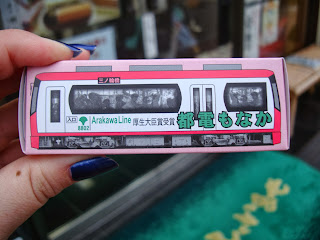This week I read an interesting article,
Eight Things Every Happy Woman Should Have, as found through the blog
Cupcakes and Cashmere. In particular, suggestion number six, a hobby, resonated with me. There are many things that I love doing, but my workaholic nature often gets in the way of enjoying my free time. Cooking and yoga are hobbies that I can easily prioritize for the sake of my health, and visiting art museums and attending lectures are hobbies that I can justify as they relate to my work, but doing something purely for the sake of hobby is often difficult to justify. While I promise myself every year that I will take a ceramics class or learn how to play the banjo, these things are really hard to find time for. So, this afternoon, in the spirit of being kind to myself, I jumped on the
streetcar and headed over to
Ogu Hachiman Shrine simply for the sake of taking photographs, taking a walk, and exploring more of Tokyo.
The fence for the shrine has inscriptions from various neighborhood groups.
A cute couple at the Miyanomae streetcar stop. They were taking photos at the shrine, and then at the station.
Ogu Shrine is a
Hachiman Shrine, and may date back to the 14th century.
Shrine selfie. Also- I really need a haircut.
The water with which believers purify themselves (washing hands, rinsing mouth) before visiting the shrine.
Guardian figures.
Looking out towards the streetcar.
To worship, one tosses a coin in the box at the shrine, rings this bell, claps twice, and says a prayer to the deity.
A lantern at the front of the shrine. It reads Hachiman Jinja (Shrine).
The box into which one can toss a coin.
Plaques that can be purchased. Believers then write their wish on the plaque and tie it up at the shrine.
I was interested to see how many people stopped at the shrine on a Saturday afternoon, many on their way home from shopping, or on bikes.
Ginko leaves starting to fall, and the smelly ginko berries.
As the weather just turned cool this week, the leaves are still green, but I'm sure they will become yellow soon.
A smaller shrine next to the main shrine.
Guardian figure for the smaller shrine.
Fortunes left at the shrine. One can pay about a dollar and receive an omikuji, or fortune. If it is a negative one, the practice is to tie it up and leave it at the shrine.



























































